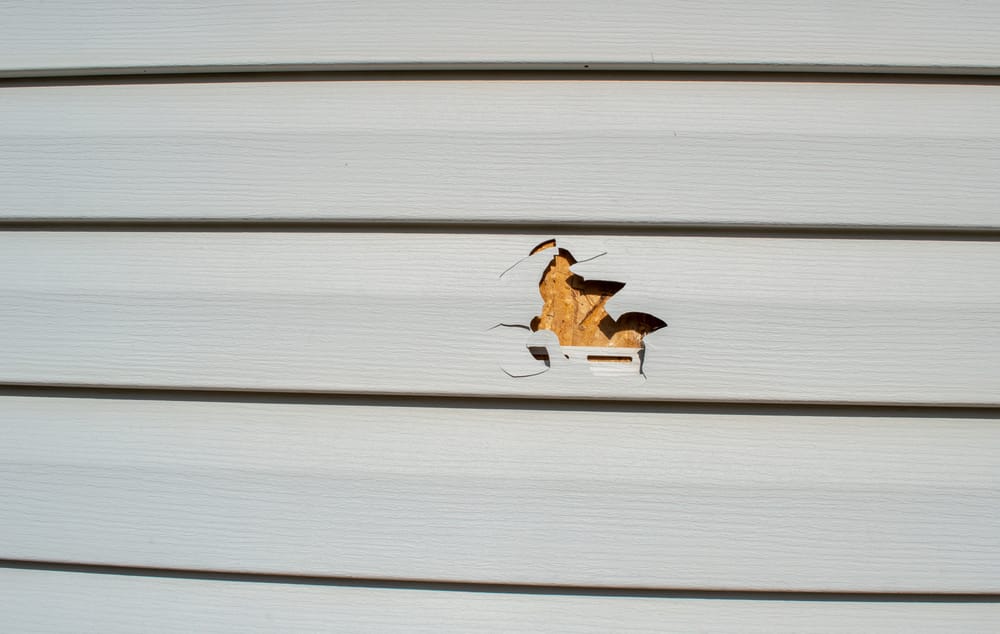Siding takes a beating from Mother Nature. Hail, wind, sun, rain – they all gang up on your home’s first line of defense. So when your siding starts showing signs of wear and tear, it’s time to take action.
Ignoring siding damage is like leaving a gaping hole in your home’s armor. Water seeps in, critters crawl through, and before you know it, you’ve got a full-blown crisis on your hands.
But fear not! Siding repair isn’t rocket science. With a little know-how and elbow grease, you can patch up those dings, dents, and holes like a pro. Ready to give your home’s exterior a facelift? Let’s get started.
Signs Your Vinyl Siding Needs Repair
Your vinyl siding is your home’s first line of defense against the elements. But over time, even the toughest siding can start to show signs of wear and tear.
Cracks or Holes
Cracks or holes in your vinyl siding are a big red flag. They let moisture seep in, leading to water damage and wood rot. Plus, they’re an open invitation for pests to make themselves at home. Is your siding looking a little wavy or buckled? That’s a sign that moisture has gotten trapped underneath. Left unchecked, it can lead to some serious structural issues.
Loose or Missing Panels
Loose or missing siding panels are like a gaping hole in your home’s armor. They leave your walls vulnerable to the elements and can even affect your neighbors’ curb appeal. Time to call in the siding repair cavalry. Faded or discolored siding isn’t just an eyesore. It’s a sign that your siding has seen better days and might not be protecting your home as well as it should.
Fungus or Mold Growth
Fungus and mold on your siding are more than just unsightly. They’re a sign of moisture damage and can lead to some serious health issues if left unchecked. Time to break out the cleaning supplies and call in the pros.
Tools and Materials Needed for Vinyl Siding Repair
So, you’ve spotted some siding damage and you’re ready to tackle the repairs yourself. Before you dive in, make sure you have the right tools and materials on hand. Safety first. Make sure you have gloves, safety glasses, and a sturdy ladder before you start any siding repair project. Trust me, your fingers and eyeballs will thank you.
Cleaning Supplies
Before you start any repairs, give your siding a good scrub with some mild soap and water. It’ll help you spot any damage you might have missed and make sure your repairs stick.
Patching and Caulking Materials
For small holes and cracks, you’ll need some vinyl caulking and a putty knife. Make sure to get color-matched caulk so your repairs blend in seamlessly.
Replacement Siding Panels
If you’re dealing with more extensive damage, you might need to replace a few siding panels. Make sure to measure twice and cut once to get the perfect fit.
How to Repair Minor Damage to Vinyl Siding
Got a few small dings and dents in your siding? No problem. With a little elbow grease and the right tools, you can have your siding looking good as new in no time. Before you start any repairs, give the damaged area a good cleaning with some mild soap and water. This will help your repairs stick and blend in better.
Apply Caulk to Small Divots
For small holes and cracks, grab your trusty caulking gun and apply a bead of color-matched vinyl caulk. Smooth it out with a putty knife and let it dry. If the damage is a bit bigger, you might need to cut out the damaged section of siding. Use a utility knife to carefully cut around the damage, being careful not to slice into the building paper underneath.
Prepare a Patch
Measure the hole you just cut out and add about an inch on each side. Cut a patch out of a new piece of siding and test the fit before you break out the caulk. Apply a bead of caulk around the edges of the hole and press your siding patch into place. Hold it there for a minute to let the caulk set.
Sand and Paint the Caulk
Once the caulk is dry, give it a quick sanding to smooth out any rough edges. Then, touch up the paint to blend your repair in with the rest of the siding.
Replacing Severely Damaged Vinyl Siding Panels
Sometimes, siding damage is too big to patch. If you’ve got cracked, warped, or missing panels, it’s time to break out the big guns and replace them entirely. Start by using a zip tool or unlocking tool to separate the damaged panel from the ones above and below it. Work slowly and carefully to avoid damaging the surrounding panels.
Remove Nails or Screws
Once you’ve got the damaged panel loose, remove any nails or screws holding it in place. A flat pry bar can help you get under the panel and pop out those stubborn fasteners. Measure the space where your new panel will go and cut a piece of siding to fit. Make sure to leave about a 1/4 inch gap on each side to allow for expansion and contraction.
Install the New Vinyl Panel
Slide your new panel into place, making sure it locks securely into the panels above and below it. Use a level to make sure it’s straight before you start nailing it down.
Secure the Siding Together
Using a siding nail gun or hammer, fasten the new panel into place. Make sure to drive the nails into the center of the nail hem to allow for movement as the siding expands and contracts.
When to Repair vs. Replace Vinyl Siding
So, you’ve found some siding damage. Now the big question is, do you repair it or replace it entirely? Here are a few factors to consider: If you’re dealing with a few small cracks or holes, a simple repair job should do the trick. But if you’ve got large sections of damaged or missing siding, it might be more cost-effective to replace the whole shebang.
Age of Siding
Vinyl siding typically lasts between 20 and 40 years. If your siding is getting up there in age and you’re seeing more and more damage, it might be time to start thinking about a full replacement. If you find yourself constantly patching and repairing your siding, it might be more cost-effective in the long run to just replace it. Plus, new siding can give your home a major curb appeal boost.
Improving Home Value
If you’re thinking of selling your home in the near future, replacing your siding can be a smart investment. New siding can improve your home’s energy efficiency and give it a fresh, modern look that buyers love.
Upgrading to More Efficient Siding
If your current siding is looking a little worse for wear, it might be time to upgrade to a more energy-efficient option. Newer siding materials can help keep your home cooler in the summer and warmer in the winter, saving you money on your energy bills.
Choosing the Right Siding Contractor for Repairs
Vinyl siding repair is not for the faint of heart. If you’re not confident in your DIY skills, it’s best to leave it to the pros. But with so many siding contractors out there, how do you choose the right one? Here are a few things to look for: – Experience: Look for a contractor who has been in the biz for a while and has a proven track record of success. – Licensing and insurance: Make sure your contractor is licensed and insured to work in your area. This protects you in case of any accidents or damage during the repair process. – References: Ask for references from past clients and actually call them. A reputable contractor should have plenty of happy customers willing to sing their praises. – Warranty: Look for a contractor who offers a warranty on their work. This gives you peace of mind knowing that if something goes wrong, they’ll be there to fix it.
Preventing Future Damage to Your Vinyl Siding
An ounce of prevention is worth a pound of cure, especially when it comes to your home’s siding. Here are a few tips to help keep your siding looking its best for years to come: Give your siding a good cleaning at least once a year to remove dirt, grime, and mildew. A simple solution of soap and water should do the trick, but for tougher stains, you might need to break out the pressure washer.
Addressing Moisture Issues
Moisture is the enemy of vinyl siding. Make sure your gutters and downspouts are in good working order and directing water away from your foundation. If you notice any leaks or water damage, address them ASAP to prevent further damage. If you’re installing new siding, make sure it’s done right the first time. Hire a reputable contractor who knows their stuff and follows manufacturer instructions to the letter. Improperly installed siding can lead to all sorts of problems down the road.
Timely Repairs
If you do notice any damage to your siding, don’t put off repairs. The longer you wait, the worse the damage can get, and the more expensive it will be to fix. Nip those problems in the bud before they have a chance to spread.
Got vinyl siding woes? Cracks, holes, or fading mean it’s time for a fix-up. Whether you’re patching up minor damage or swapping out whole panels, having the right tools and knowing when to DIY versus calling in a pro can save your home’s skin. And don’t forget—regular upkeep keeps bigger issues at bay.
Conclusion
Siding repair is all about nipping problems in the bud. Catch those cracks and holes early, and you’ll save yourself a world of headaches down the road.
Remember, your home’s siding is its first line of defense against the elements. By keeping it in tip-top shape, you’re not just boosting your curb appeal – you’re protecting your biggest investment.
So go forth and tackle those siding repairs with confidence. Your home will thank you, and your wallet will too. Happy fixing!












